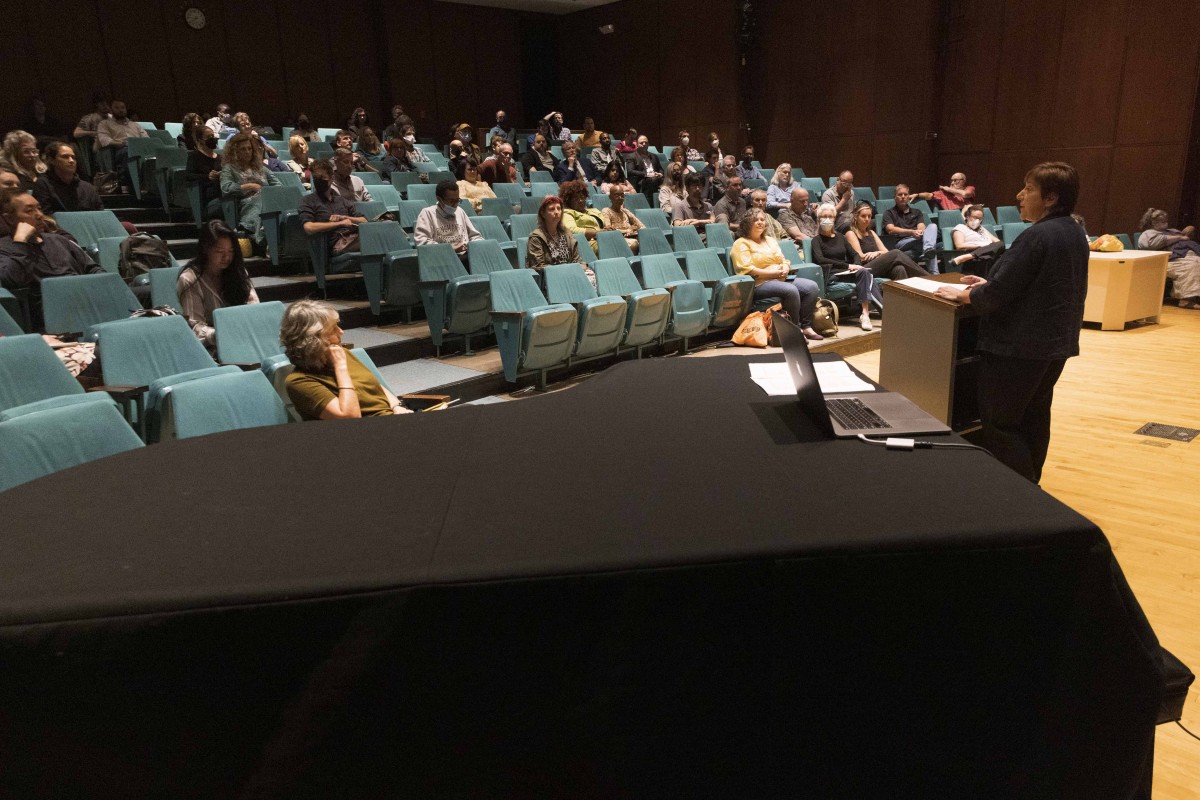Raise the curtain: Town hall discusses Harpur School of the Arts

The arts have long been a source of strength at Harpur College of Arts and Sciences, with alumni appearing on the stage and the screen, in the writers’ room and behind the camera lens. Others go on to become arts-focused benefactors and philanthropists, while pursuing careers in other areas.
The time is right to establish a School of the Arts within Harpur College, according to Dean Celia Klin.
The campus community had the opportunity to learn more about the project on Sept. 7 in the Casadesus Recital Hall. During a town hall session, Beatrice Szalas of the marketing firm Red Cactus discussed what she found during a competitive market analysis of the project, and how a designated art school could fare against competing and peer institutions.
Expect more conversations over the next few years as the project takes shape, Klin said.
“Harpur College has a long history of providing a rigorous liberal arts education that is both broad and deep, with a commitment to a transformative education, excellence in scholarship and creative activity, and a commitment to creating an accessible, welcoming environment,” Klin said. “To accomplish that, we continually need to take stock and see where we are going.”
Discussions on the new school began in earnest in 2019. It would be centered on five existing departments: art and design, art history, cinema, music and theatre.
Right now, the proposal is making its way through Binghamton University’s Faculty Senate. A search committee has also been formed to find the school’s first director. Also at play: The Fine Arts Building is due to undergo renovations, a process that will be both expensive and time-consuming.
“We want to make sure that we design a building that works for the college in 10 years and 20 years, 30 years, because it won’t happen again anytime soon,” Klin said. “We need to provide the breadth that students want and need, and that means being really deliberate in the way that we shape the college. And right now, that means building in the arts.”
‘A special kind of school’
The goal isn’t to establish a conservatory, but instead draw on Binghamton’s unique strengths as a high-quality public university.
Some students choose Binghamton specifically to study the arts, but others discover the opportunities only after they arrive. And then there are students with specific career goals who may have participated in theater or music in high school; rather than give up these interests in college, they find a way to pursue them, whether as through a double-major, a minor or through participating in theater productions, the orchestra or groups outside their degree program.
Szalas conducted focus groups and interviews with Binghamton faculty, staff and alumni on what makes Binghamton and Harpur special, reviewed data and statistics, and compared Binghamton to key competitors and aspirational peers. Every focus group brought up how students can and do double-major in wildly divergent areas, she said. One alumna had majored in music and chemistry; while she’s currently pursuing music, her Plan B is becoming a doctor, she told Szalas.
Harpur College already has a collaborative and interdisciplinary spirit when it comes to the arts: Consider the spring 2022 premiere of “Word of Mouth,” in which music majors created compositions around poems written in creative writing classes, which were then performed by other music students. A School of the Arts could spur new cross-arts collaborations, and strengthen interactions between other programs and campus groups, Klin said.
Prospective students are also interested in the arts. From 2019 to 2020, the visual and performing arts were the 10th most popular major nationwide, with more than 155,000 degrees awarded, an increase of 13.8% over the prior year, Szalas said in her report.
Plus, for the last decade, the U.S. Bureau of Labor Statistics has forecasted the increasing need for artists and designers. A National Endowment for the Arts report also predicted a need for set and exhibit designers, actors, producers, and film and video editors from 2016 to 2026. The creativity and critical thinking central to the arts is also an asset in the employment world in other ways; arts majors can be found in a wide range of companies and roles, Szalas pointed out.
“I believe we have an opportunity to create a special kind school, where the students are exposed to multiple disciplines and double-major opportunities, state-of-the-art facilities, internships and performances that connect graduates to real, in-demand job opportunities,” Szalas said.
The larger Binghamton community also embraces the arts, from public events such as LUMA and Porch Fest to performances by the Binghamton Philharmonic and Tri-Cities Opera. Arts events offered through the University could foster more community interaction and contribute to the region’s success.
“We know that communities that are rich in the arts are communities where people want to live,” Klin said.
There are, however, challenges. Binghamton has a reputation for academic strength, particularly in fields related to science, technology, engineering and mathematics (STEM); it’s not as well-known in the arts, which makes getting the word out a priority once the school takes shape.
However, Binghamton has the opportunity to inject its population of “hardworking, scrappy, non-privileged students” into an art school environment that is grounded in the realities of the art world, focus group respondents pointed out to Szalas. In turn, having “School of Arts” on a resumé may aid graduates in pursuing arts-related careers and instill pride in their alma mater.
“Rather than another ‘stodgy arts college,’ let’s make sure that we distinguish ourselves and prepare our graduates to go out and make a real difference in the creative economy,” Szalas recounted.
